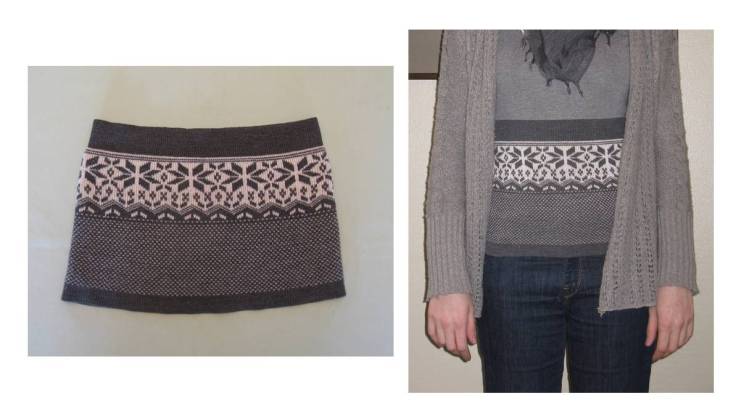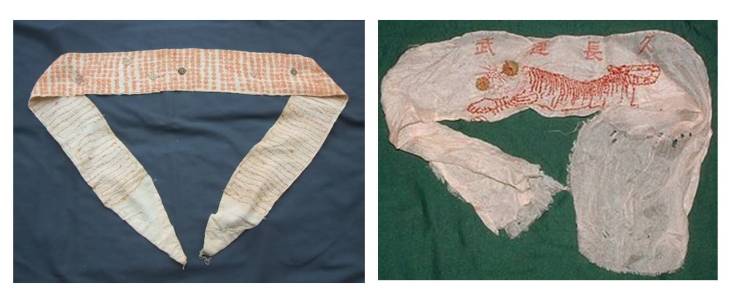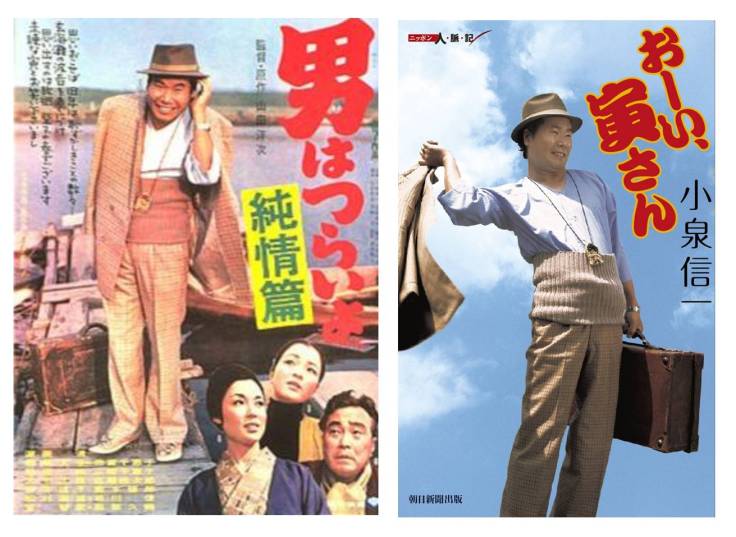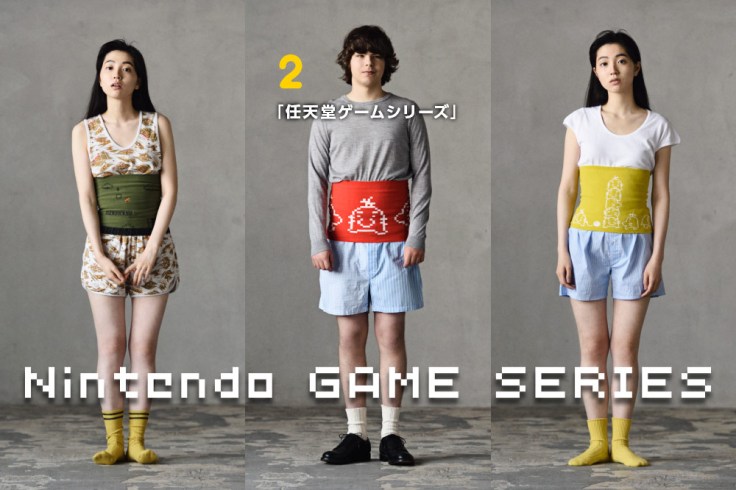Haramaki is a type of Japanese undergarment. It literally translates as ‘belly wrap’ (腹巻). I first learned about haramaki when shopping at Japanese clothing store Uniqlo. In the underwear section, I saw a tube-like knitted item that seemed perfect for keeping my neck warm at night. Shortly after having bought two ‘neckwarmers’, I saw a tv program where foreigners were being interviewed about life in Japan. The foreigners commented on the peculiar Japanese habit of wearing belly warmers. Hence my introduction to the haramaki. Ever since discovering its intended purpose, I wear haramaki in winter for extra warmth or whenever I have lower back pains.

When looking for background on haramaki, I was surprised to find mostly fashion related information. I had thought of the haramaki more as an item that one wears for health purposes but apparently it is making a comeback as a fashion piece. This is remarkable because the haramaki was traditionally considered an out-of-date item worn by old men.
The history of the haramaki goes back to feudal Japan, where it was a type of armour worn by infantry soldiers. According to Wikipedia, haramaki refers to any Japanese armour which is put on from the front and then fastened in the back with cords.

Later on, during the First Sino-Japanese War and World War II, a soldier going off to fight was often given a senninbari haramaki (“1,000 stitch belt”) by his family. A mother, sister, or wife would stand on the street and ask passing women to contribute a stitch until 1,000 had been collected. The garment was meant to both provide warmth and serve as a talisman to ward away harm.

The haramaki then evolved to its current form: a circular tube of fabric worn around the midriff and hips. During the 70’s and 80’s, it was considered an out-of-date type of underwear for old men. Contributing to this image were various characters from popular culture like the manga series Tensai Bakabon, which stars a dim-witted boy and his insane father. The father always wears a haramaki.

Another example is Tora-san, the main character in a series of movies about a kind-hearted vagabond who is always unlucky in love.

The transition of haramaki from out-of date underwear to fashionable mainstream item is mostly credited to Japanese game designer and entrepreneur Itoi Shigesato. Itoi had been wearing haramaki for years despite their old-fashioned reputation and perception as an unfashionable undergarment when he started selling haramaki in 2001 through his company Hobonichi. Hobonichi reinvented haramaki as fashion items to layer with your clothes. He even worked with Nintendo to make Nintendo-themed haramaki. If you are interested in buying some trendy Hobonichi haramaki, you can go to the English language Hobonichi webshop. You can wear these haramaki directly over your skin, over an undershirt and under your shirt, or completely over your shirt. If you are more into plain haramaki, you might try British shop Nukunuku.

While not everyone may agree about the fashion merit of haramaki, there is no denying that haramaki help to keep you warm. Have a look at the chart below:

The Japanese love to talk about how important a warm stomach is to staying well. They attribute all sorts of health benefits to it. In any case the added heat provided by haramaki is very welcome during cold Japanese winters without central heating systems. If you want to know more about keeping warm during winter in Japan, you can read my post 6 ways to keep warm during Japanese winter.
What do you think about haramaki? Is it a fashion-do or don’t? Only for grandpa’s or great for young people too? Let me know what you think in the comments section!
Great article. It came out first when I googled Japanese belly warmer and sourced a lot from it for my own article about my hipi sleek, protective hip bag resembling a haramaki. Credited and linked to your article, of course. Hope you don’t mind my linking to my post? https://www.hipi.fit/hipi-japanese-belly-warmer-well-i-never/
I came across them when I was in Japan and I bought a couple when I was there. They are so comfortable and keeps my tummy warm. How can I buy some.
It’s fashion do… 😍 and I think it’s great for kids to keep them warm during their sleep… 😊
i never knew about this trend in fashion in japan. well, i’m perfectly happy with my uniqlo heat tech clothing. those keep me warm enough in cold climate countries when i travel.
Yes heat tech is great. And less bulky. Although Uniqlo also has heat tech haramaki. Double strength? 🙂
really? they do? hhmm… maybe they sell that only in japan? or four-season countries? ’cause i have never seen one at uniqlo here in indonesia.
I saw them in Japan and also in US and UK Uniqlo web shops: http://www.uniqlo.com/us/product/women-heattech-body-warmer-fair-isle-079248.html Actually I don’t know if Uniqlo sells them in Belgium. I will check next time I am in the shop.
do they display it at the woman’s section? maybe that’s why i never seen one, as i never venture that side of the shop. or could be that it’s available only at four-season countries, as these are the potential markets for the body warmer. south east asia would be too hot to make a lot of sales on this item.
It was displayed at the women’s underwear section. But since I never venture into the men’s section, I don’t know if men’s haramaki were displayed there.
I just found out that Hobonichi (who produces my favorite daily planner) also makes haramaki! Because that totally makes sense – paper stationary goods PLUS knitted elasticized belly bands. Haha. Here’s a link to a photo which I posted on my blog – http://bit.ly/1MsCsdc. The design is so cute!
Yes, I also refer to Hobonichi in this post. They make the Nintendo themed haramaki, amongst others. When I was researching this article, I read a description about Hobonichi saying that the company philosophy is to produce any kind of product they like, simply because they like it. Great philosophy and it seems to work! 🙂
I love that! I think that philosophy really comes through in their products. Whenever I order something from Hobonichi, it comes with a little free gift. From most companies, I just throw those away, but the Hobonichi freebies are amazing! They have made a loyal customer of me. 🙂
You are really making me interested in Hobonichi. Other than their haramaki, I don’t know their products but I will check them out thanks to your enthusiastic comments 🙂
My top recommendation is their daily calendar! Hope you find something to love too, Jessy
this is my first time learning about it. interesting. i wonder if outdoor gear/clothing companies would sell this as part of their winter collection.
That’s a good idea. Maybe some already do? I don’t know…
I think I used to wear one in kindergarden or before that. It was a very unfashionable item that when you started elementary school and you had gym classes when you had to change, you stopped wearing it though my memory is very vague.
Nowadays many Japanese women prefer warmth to fashion or keeping warm shouldn’t stand in the way of fashion so we have all sorts of ways to keep fashionably warm. ^^
Yes I love Uniqlo’s heat tech clothing. Recently the first Uniqlo opened in Belgium. So happy! Personally, the colder it gets, the less I care about fashion 🙂
The first time I went to Japan, I stayed at my Japanese aunt’s childhood home, where her elderly father still lived. It was a bit of a shock for me to see him walking around in his underwear, and I was indeed perplexed by his haramaki.
Although the “keep your stomach warm” thing really bothered me the first times I heard it, especially in summer, now that I’ve been through a few winters in Japan I can see the appeal. I haven’t actually worn them myself, but they might be worth a shot for overall well-being in the cold.
I started wearing mine again after writing this article 🙂 Why don’t you give it a go to see if you like it? Even if you don’t like it, you will have had another Japanese culture experience.
By the way, I went to Mono Japan in Amsterdam last weekend and met a man from Matsue Omotesenke. He gave us tea (delicious, matcha from Matsue!) and was really impressed that I knew about the chakai in Matsue castle. That is thanks to you! 🙂
Very cool! Odds are good I might have met this man before. Though if he’s not in my school, I probably don’t remember his name…
Unfortunately we didn’t ask his name.
We also have something similar in Italy. It is called PANCERA as it keeps the “pancia” (belly) warm. Normally it is an undergarment item, never worn on the outside and it is made of wool. Basically it is also something that an elderly would wear (I have some from my Grandma) or if you have back-ache.
Anyway, the Japanese way to wear it (on clothes) is cute and remind me a bit of a modern obi. 😉
I didn’t know there was a European version of haramaki. Interesting! And I hadn’t thought of the comparison with obi either, but it makes sense. Thanks! 🙂
In recent years the “pancera” has had a more aesthetic purpose (to slim down your figure aka “keep the belly in”), and also for medical purpose (to suppor pregnant women’s belly or to support your back) but the origin was simply to keep warm the belly/back area. If you google “pancera di lana” (woollen pancera), you’ll see all the variations. 😉
Thanks, I googled it and indeed it looks just like a haramaki. The one for keeping your belly in and having a slimmer figure we have in Belgium as well (litt. translated “supportive underwear”). And maybe some orthopedic aid will exist for people with back problems. But as far as I know we don’t have the wool one for keeping warm. Maybe it exists in Belgium and I don’t know about it?